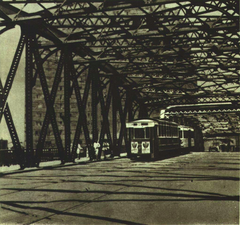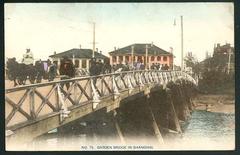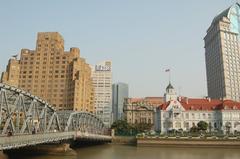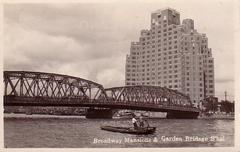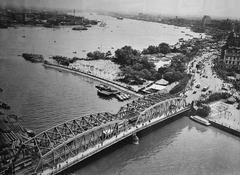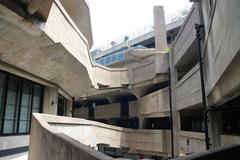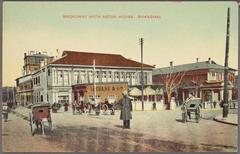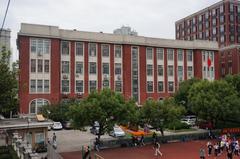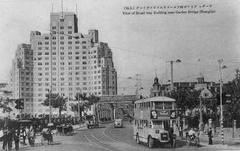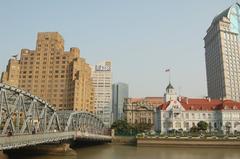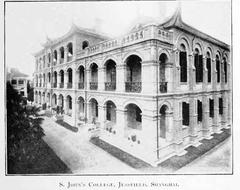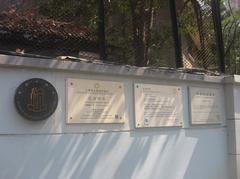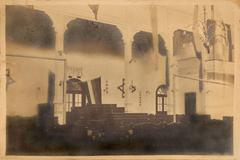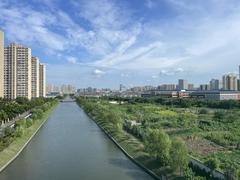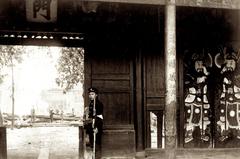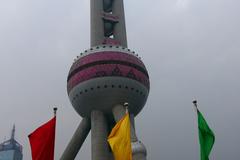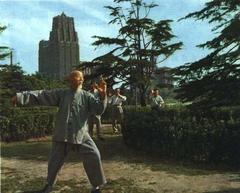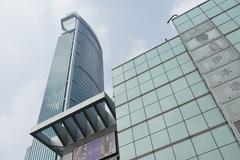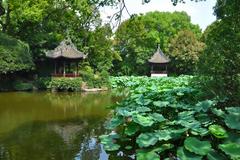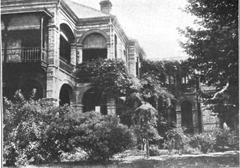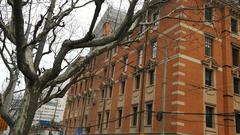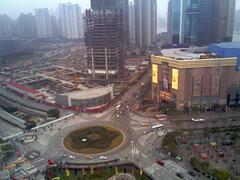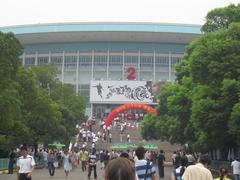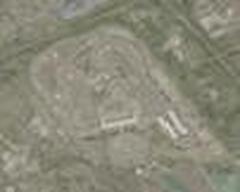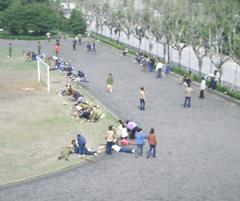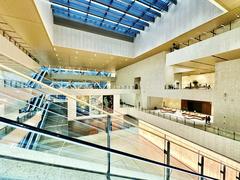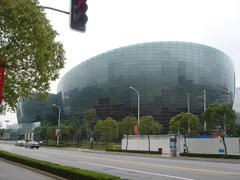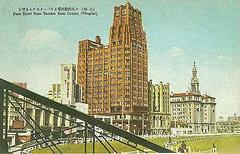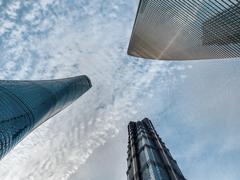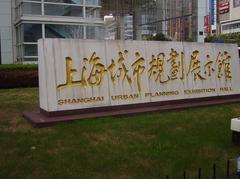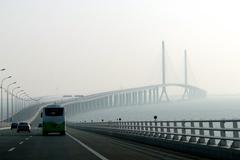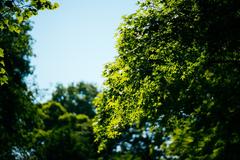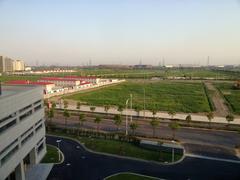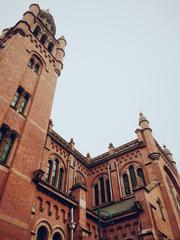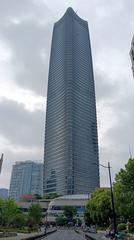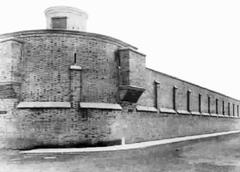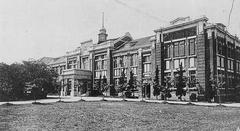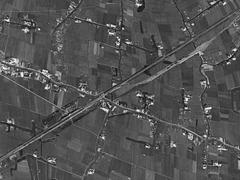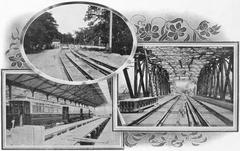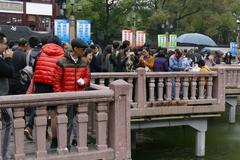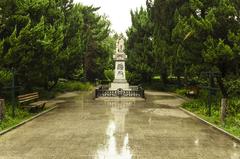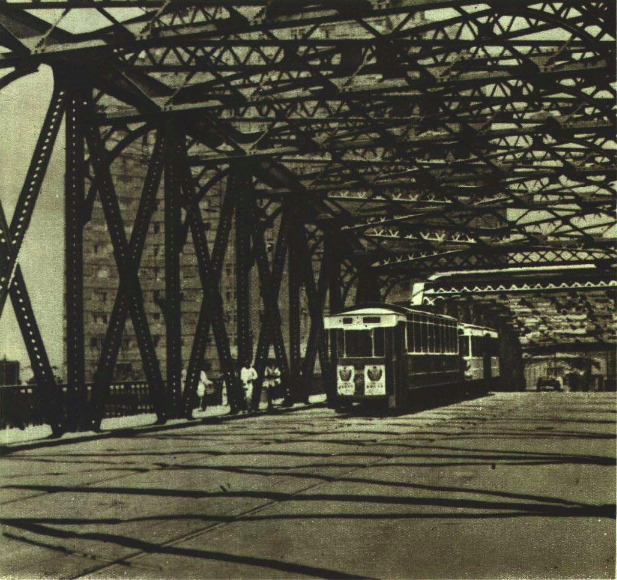
Comprehensive Guide to Visiting Waibaidu Bridge, Shanghai, People’s Republic of China
Published Date: 01/08/2024
Introduction to Waibaidu Bridge
Waibaidu Bridge, also known as the Garden Bridge, is one of Shanghai’s most iconic landmarks. Spanning the Suzhou Creek, it connects the Huangpu and Hongkou districts, offering stunning views of the city’s skyline. Officially opened in 1908, Waibaidu Bridge was the first all-steel bridge in China, replacing an earlier wooden structure built in 1856 by British businessman Charles Wills (Discover Walks). Its construction marked a significant milestone in Shanghai’s modernization, incorporating Western engineering practices in its camelback truss design, which was rare at the time (Discover Walks).
The bridge also holds historical significance due to its role during the liberation of Shanghai in 1949. As the People’s Liberation Army advanced into the city, Waibaidu Bridge served as a strategic entry point, symbolizing the liberation from Kuomintang forces (Shine). Today, Waibaidu Bridge is not only a functional piece of infrastructure but also a cultural icon featured in numerous films and television series, reflecting Shanghai’s blend of historical and modern elements (Trip.com).
This comprehensive guide provides valuable insights into visiting Waibaidu Bridge, including its historical background, architectural significance, visitor information, and tips for making the most of your trip. Whether you are a history enthusiast, a photography lover, or a curious traveler, this guide will help you explore one of Shanghai’s most treasured landmarks.
Table of Contents
- [Historical Background of Waibaidu Bridge](#historical-background-of-waibaidu-bridgehistorical-background-of-waibaidu-bridge)
- [Early Conception and Construction](#early-conception-and-constructionearly-conception-and-construction)
- [Architectural Significance](#architectural-significancearchitectural-significance)
- [Role in Shanghai’s Liberation](#role-in-shanghais-liberationrole-in-shanghai-s-liberation)
- [Visiting Waibaidu Bridge](#visiting-waibaidu-bridgevisiting-waibaidu-bridge)
- [Visiting Hours and Tickets](#visiting-hours-and-ticketsvisiting-hours-and-tickets)
- [How to Get There](#how-to-get-therehow-to-get-there)
- [Nearby Attractions](#nearby-attractionsnearby-attractions)
- [Accessibility](#accessibilityaccessibility)
- [Preservation and Restoration](#preservation-and-restorationpreservation-and-restoration)
- [Cultural Impact](#cultural-impactcultural-impact)
- [Modern-Day Relevance](#modern-day-relevancemodern-day-relevance)
- [Visitor Experience](#visitor-experiencevisitor-experience)
- [Commemorative Events](#commemorative-eventscommemorative-events)
- [Frequently Asked Questions](#frequently-asked-questionsfrequently-asked-questions)
- [Conclusion](#conclusionconclusion)
- [References](#referencesreferences)
Historical Background of Waibaidu Bridge
Early Conception and Construction
Waibaidu Bridge, also known as the Garden Bridge in English, holds the distinction of being the first all-steel bridge in China. Its construction was a significant milestone in the modernization of Shanghai’s infrastructure. The bridge was officially opened in 1908, replacing an earlier wooden bridge that had been in place since 1856. The original wooden bridge, known as the Wills’ Bridge, was constructed by a British businessman named Charles Wills. However, due to the increasing traffic and the need for a more durable structure, the decision was made to build a steel bridge (Discover Walks).
Architectural Significance
Waibaidu Bridge is a camelback truss bridge, a design that was relatively rare at the time of its construction. This type of bridge is characterized by its arched trusses, which provide both strength and aesthetic appeal. The bridge’s design was influenced by Western engineering practices, making it one of the first structures in China to incorporate such techniques. Its construction marked a significant step in the adoption of modern engineering methods in Shanghai (Discover Walks).
Role in Shanghai’s Liberation
Waibaidu Bridge played a crucial role during the liberation of Shanghai in 1949. As the People’s Liberation Army (PLA) advanced into the city, the bridge became a strategic point of entry. Historical photographs show PLA cavalry marching across the bridge, symbolizing the liberation of the city from Kuomintang forces. The bridge’s proximity to key locations such as the Shanghai Postal Museum and the Broadway Mansion made it a focal point during the final stages of the battle (Shine).
Visiting Waibaidu Bridge
Visiting Hours and Tickets
Waibaidu Bridge is open 24 hours a day and does not require an entry fee, making it an accessible and budget-friendly attraction for all visitors. This allows tourists to plan their visit at any time, whether they want to capture the morning light or the evening glow.
How to Get There
The bridge is conveniently located near the Bund, a famous waterfront area. Visitors can take the Shanghai Metro Line 2 to East Nanjing Road Station and walk approximately 10 minutes to reach the bridge. Alternatively, several bus routes service the area, and taxis or ride-sharing services are readily available.
Nearby Attractions
In addition to the Bund, visitors can explore nearby attractions such as the Shanghai Postal Museum, the Broadway Mansion, and Suzhou Creek. These sites offer a deeper dive into Shanghai’s historical and cultural landscape.
Accessibility
Waibaidu Bridge is accessible to pedestrians, cyclists, and vehicles. The walkway is wide enough to accommodate wheelchairs and strollers, ensuring that everyone can enjoy the scenic views and historical significance of the bridge.
Preservation and Restoration
Over the years, Waibaidu Bridge has undergone several restorations to preserve its historical and architectural integrity. One of the most significant restorations took place in 1991, when the bridge was temporarily dismantled and refurbished. This restoration aimed to maintain the bridge’s original design while ensuring its structural stability. The bridge was reassembled and reopened to the public, continuing to serve as a vital link between the Huangpu and Hongkou districts (Discover Walks).
Cultural Impact
Waibaidu Bridge is not just an architectural marvel; it is also a cultural icon. The bridge has been featured in numerous films and television series, often symbolizing the blend of old and new Shanghai. Its picturesque setting, especially during sunset, makes it a popular spot for photographers and tourists alike. The bridge’s cultural significance is further highlighted by its inclusion in various city tours that explore Shanghai’s rich history and heritage (Trip.com).
Modern-Day Relevance
Today, Waibaidu Bridge continues to be a vital part of Shanghai’s urban landscape. It serves both as a functional piece of infrastructure and a historical landmark. The bridge’s location near the Bund, a famous waterfront area, makes it a popular destination for both locals and tourists. Walking across the bridge offers stunning views of the Suzhou Creek and the contrasting architectural styles on either side—old-fashioned lanes to the north and Western-style buildings to the south (Discover Walks).
Visitor Experience
For visitors, Waibaidu Bridge offers a unique blend of history and scenic beauty. The bridge is easily accessible and provides a perfect vantage point for capturing panoramic views of the city. It is particularly enchanting during the early morning hours when locals can be seen practicing Tai Chi or jogging along the Bund. The bridge’s romantic ambiance at sunset makes it a favored spot for couples and photographers looking to capture the golden hues reflecting off the steel structure (Trip.com).
Commemorative Events
Waibaidu Bridge often serves as a venue for commemorative events and exhibitions that celebrate Shanghai’s history. For instance, the Shanghai Archives has hosted exhibitions featuring historical photographs and documents related to the bridge and its role in the city’s liberation. These events provide visitors with a deeper understanding of the bridge’s historical significance and its impact on Shanghai’s development (Shine).
Frequently Asked Questions
Q: What are the visiting hours for Waibaidu Bridge?
A: Waibaidu Bridge is open 24 hours a day.
Q: Is there an entry fee to visit Waibaidu Bridge?
A: No, there is no entry fee to visit Waibaidu Bridge.
Q: How can I reach Waibaidu Bridge using public transportation?
A: You can take the Shanghai Metro Line 2 to East Nanjing Road Station and walk approximately 10 minutes to the bridge. Several bus routes also service the area.
Q: Are there any nearby attractions to visit after Waibaidu Bridge?
A: Yes, nearby attractions include the Bund, the Shanghai Postal Museum, and the Broadway Mansion.
Conclusion
Waibaidu Bridge stands as a testament to Shanghai’s rich history and its journey towards modernization. From its early days as a wooden bridge to its current status as a steel architectural marvel, the bridge has witnessed and played a role in many of the city’s pivotal moments. Its blend of historical significance, architectural beauty, and cultural impact makes it a must-visit landmark for anyone exploring Shanghai. Whether you’re a history enthusiast, a photography lover, or simply a curious traveler, Waibaidu Bridge offers a unique and memorable experience (Discover Walks, Trip.com).
References
- Discover Walks. (n.d.). Top 5 Bridges to See in Shanghai. Discover Walks
- Shine. (n.d.). Waibaidu Bridge: Witness to History. Shine
- Trip.com. (n.d.). Shanghai Iconic Landmark Guide to the Bund. Trip.com
- chinatripedia.com. (n.d.). Waibaidu Bridge: Shanghai’s Iconic Landmark on the Bund. chinatripedia.com
- shdaily. (n.d.). Waibaidu Bridge: Witness to History. shdaily
- Wikipedia. (n.d.). Waibaidu Bridge. Wikipedia
- China Dragon Tours. (n.d.). Waibaidu Bridge in Shanghai. China Dragon Tours
- Rove.me. (n.d.). Best Time to Visit Shanghai. Rove.me
- Asia Odyssey Travel. (n.d.). The Bund in Shanghai. Asia Odyssey Travel
- Trek Zone. (n.d.). Waibaidu Bridge in Shanghai. Trek Zone
- China Discovery. (n.d.). The Bund. China Discovery
- China Highlights. (n.d.). The Bund. China Highlights
